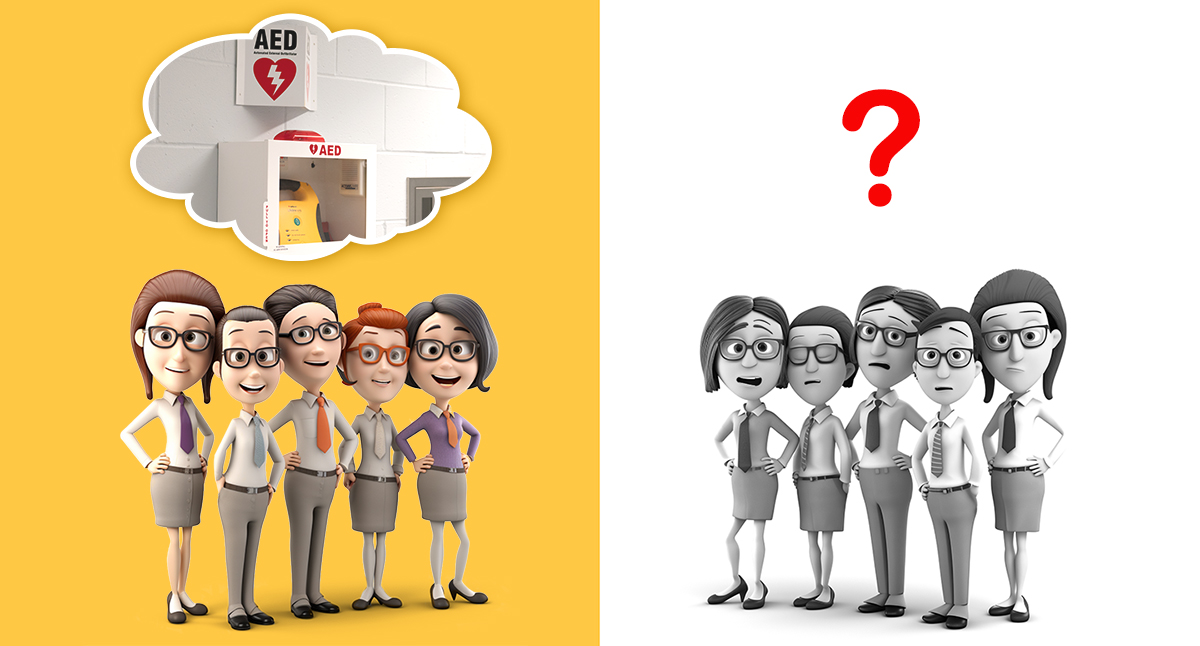Does Your Office Have a Plan?
May 3, 2023

According to the American Heart Association, 436,000 Americans die from sudden cardiac arrest each year. More than 350,000 of these SCA's occur outside of the hospital. It is crucial that the Chain of Survival is activated when someone suffers sudden cardiac arrest to ensure the highest possible chances of survival. The chain of survival consists of six steps:
- - Activation of Emergency Response
- - High-quality CPR
- - Defibrillation
- - Advanced Resuscitation
- - Post-Cardiac Arrest Care
- - Recovery
It is necessary that the first three steps in the Chain of Survival occur before an ambulance arrives. According to a report from the US Occupational Safety & Health Administration, there are approximately 10,000 cardiac arrests in the workplace each year. Only 50% of US office workers are able to locate an AED. It is crucial that your office has a complete AED program to ensure that someone in sudden cardiac arrest has the best chance to survive.
AED
Buying an AED is a great first step, but it is important to remember that
one AED might not be enough. Each minute that goes by without a shock from an AED, decreases a person’s chances of survival by 10%. Therefore, it is critical that an AED is always accessible within 3 minutes of all locations in an office building.
AEDs should never be in a locked room or cabinet. They should be on the wall in an alarmed wall cabinet. When the cabinet door opens, an alarm will sound, alerting people there is an emergency. There should also be signage throughout the office noting where the AEDs are located and a 3-dimensional AED sign hung above the AED.
Employee Training
Providing First Aid, CPR, and AED training to your employees is a great way to empower them to help save a life, not only in the workplace, but within their communities. There are many different options for providing training or certification. A few companies that provide certifications are:
- - American Heart Association
- - American Red Cross
- - American Safety & Health Institute
This is a great benefit to offer your employees.
Maintenance
The battery and pads of AEDs do expire over time. When buying and placing an AED, it is important to take note of the expiration date of your battery and pads. There are great program management systems available like DefibtechMD to help you maintain your AED to ensure it is always ready for use. If you prefer to maintain the AED on your own, someone should be doing monthly checks and charting the date when those checks are done. Here are some things to look for when checking an AED:
- - Is the Active Status Indicator light on your AED flashing green?
- - Are the AED pads plugged in and ready for use?
- - Does the AED appear to be undamaged and ready for use?
- - Is the AED free of chirping and warning notifications?
- - Are the AED pads within their usable date?
- - Is the AED battery within its usable date?
- If the answer to any of these questions is no, call Customer Service immediately to determine what the issue might be with the AED.
Cardiac Emergency Action Plan
All office buildings need to have a Cardiac Emergency Response plan that is written and reviewed frequently. This plan should include:
- - Names and expiration dates of employees that are First Aid/CPR/AED certified
- - A written plan describing steps taken when sudden cardiac arrest occurs
- - Company Maintenance Plan
- - Location of all AEDs in the building
This plan should be communicated with all employees and practiced. It should be reviewed each year and updated if needed. The plan should also be communicated to local Emergency Medical Services (EMS).
With the large number of sudden cardiac arrests occurring in the workplace each year, it is crucial that a complete safety program is implemented to give everyone the best possible chances for survival.
To learn more about Defibtech and to join us on our quest to save lives from sudden cardiac arrest, visit www.Defibtech.com.
Sources:
https://cpr.heart.org/en/resources/cpr-facts-and-stats
https://cpr.heart.org/en/training-programs/workforce-training
https://cpr.heart.org/en/resources/cpr-facts-and-stats/out-of-hospital-chain-of-survival
